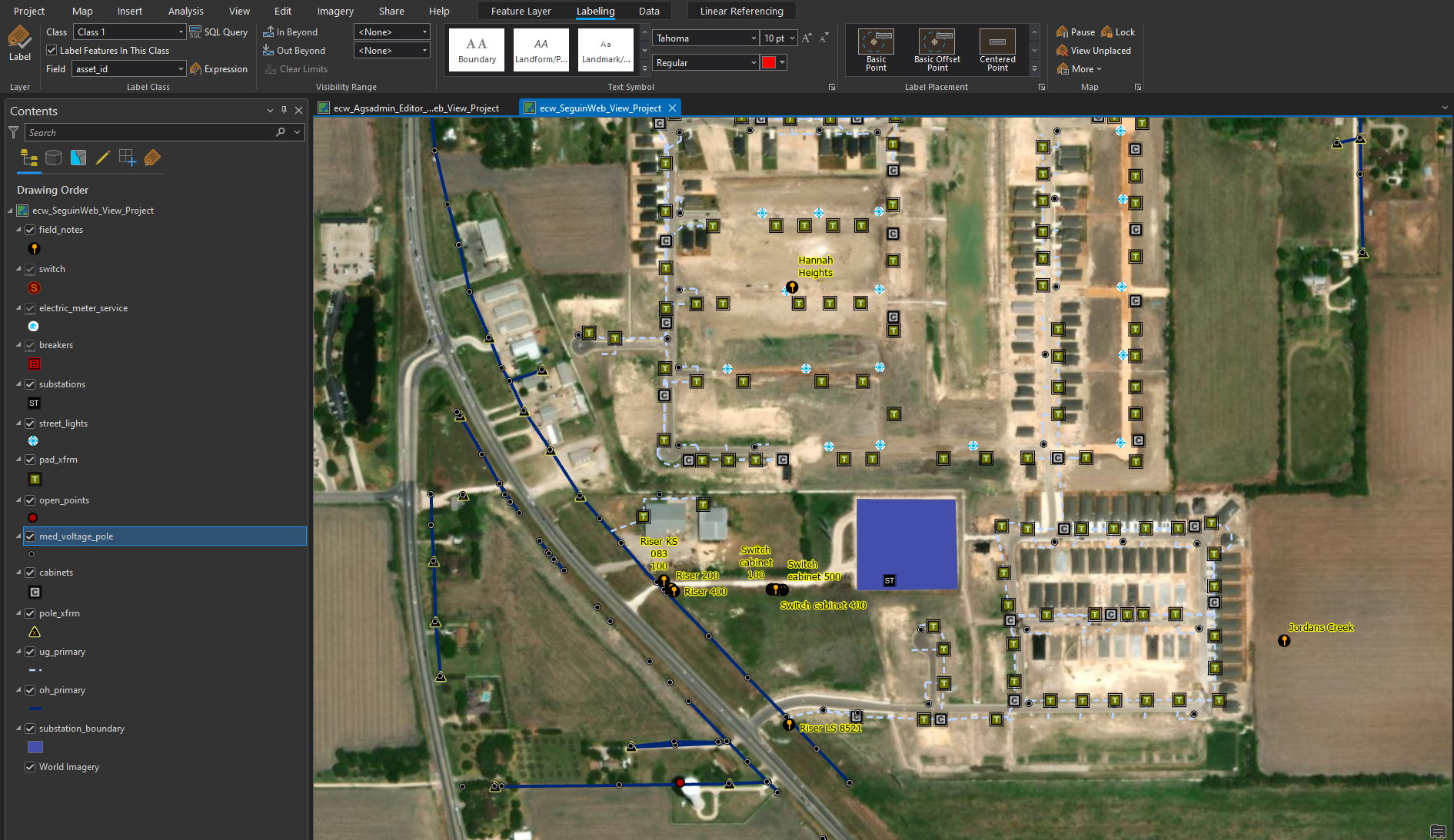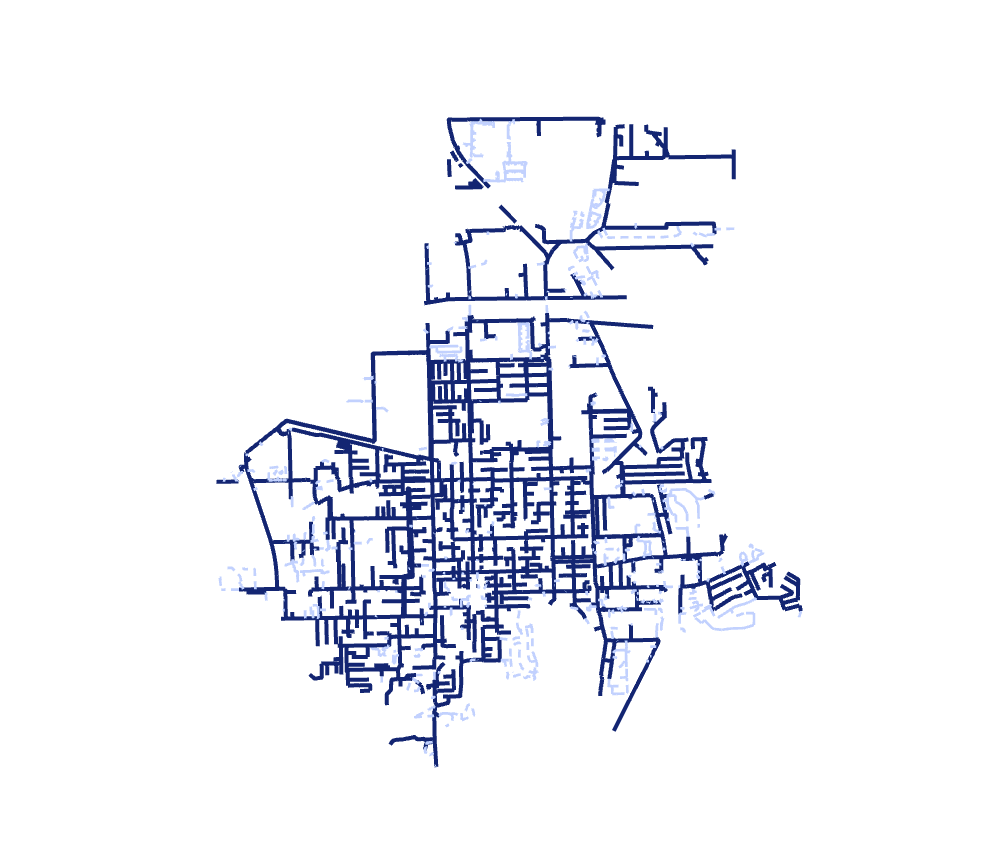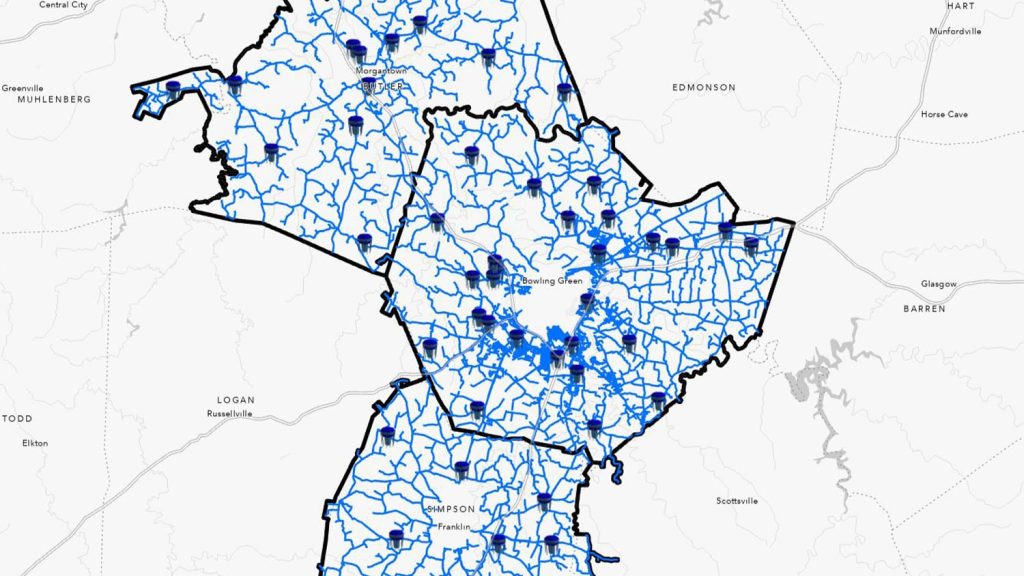Seguin’s Utilities Services Department uses high-accuracy maps to assist compliance with regulations and to migrate their electric network to the ArcGIS Utility Network
About one hour northeast of San Antonio, Texas, the small city of Seguin serves just over 30,000 residents with water, wastewater, and electric utilities. According to Smart Grid Solutions Manager John Saldana, residency is expected to have solid growth in the next five years.
Within the Utility Services Department, Saldana creates systems that tie together the Water Utility Department and Electric Utility Department.
“If anyone needs a map for internal, non-public information — whether it’s electric, water or sewer — in order to support utility infrastructure projects, that comes from us,” Saldana said. “We are the middleman between utilities and the city, so we support all of their technology needs, beyond the traditional IT department.”

Increased Development Drives the Need for Accurate Utility Maps
“The assets are all very close in proximity to each other, so it’s important that we have the best accuracy we can. We’re trying to prevent accidents with water and electricity.”
— John Saldana, Solutions Manager, Smart Grid Team, City of Seguin
The city of Seguin is experiencing solid growth as it expands toward neighboring New Braunfels, and vice versa. As farmland between the cities is developed, the demand for municipal water, sewer, and electric services is rising.
“When that first happened, we started seeing they had requirements for how much accuracy we had to provide them in order to connect our water mains,” Saldana said.
The city wanted to find a way to accurately map both existing assets prior to development and new construction as utilities are installed. In this way, they help builders avoid hitting existing utility infrastructure during construction and set themselves up for future success, when crews will inevitably be sent to service the utility grid.
“The assets are all very close in proximity to each other, so it’s important that we have the best accuracy we can,” Saldana said. “We’re trying to prevent accidents with water and electricity.”

The Solution: ArcGIS Field Maps, Arrow Gold GNSS Receivers, iPads
Saldana equipped field crews with ArcGIS Field Maps, which allowed him to control incoming data quality.
“Data does not exist in a silo,” Saldana said. “It’s designed to be shared, expanded upon, integrated, and consumed upstream and downstream. We keep this in mind as we’re building and capturing something as simple as a point. This is where it all starts. That information keeps flowing through the systems to build upon these projects and information to whoever would like to use it.”
To ensure location data comes in with high accuracy, Saldana deployed four Arrow Gold® global navigation satellite systems (GNSS) receivers from Esri Partner Eos Positioning Systems. The Arrow Gold receiver connects to an Arrow Gold base station, which provides real-time kinematic (RTK) corrections that allow field crews to stream survey-grade locations into ArcGIS Field Maps on iPad® devices.

Saldana tried many GNSS receivers before choosing the Arrow Gold, but each came with its own limitations. These included expensive subscription, complex training, inability to achieve advertised level of accuracy, poor customer service, and in one case, a receiver that could no longer support the evolution of Esri apps.
“All told, we had gone through several other manufacturers and their products, and they were just not what we were looking for,” Saldana said. “With our small team, we have limited resources, limited budgets, and diverse projects. So, we’re always looking for technology that is very simple but also complex enough to handle a variety of situations.”
The city also chose to install its own Arrow Gold base station to control its RTK corrections, after testing various private base stations in the area.
“We would pay a fee to use them, but they were down too often,” Saldana said. “They just weren’t giving us the right amount of reception and satellites needed, and we noticed a lot of base stations, especially those in rural areas, were not maintained too well.”
The Workflow: Capturing Existing Assets and New Developments
“Data does not exist in a silo. It’s designed to be shared, expanded upon, integrated, and consumed upstream and downstream. We keep this in mind as we’re building and capturing something as simple as a point. This is where it all starts. That information keeps flowing through the systems to build upon these projects and information to whoever would like to use it.”
— John Saldana, Solutions Manager, Smart Grid Team, City of Seguin
Today, the city of Seguin employs one full-time data collection employee who captures high-accuracy data all day long. All other field staff have been trained to use field data-collection setup with ArcGIS Field Maps and the Arrow Golds.
To map existing utilities, Saldana waits to hear the key action-items from the city’s pre-development meetings. There, landowners, builders, and other stakeholders discuss what utilities are currently on the land, how best to tie them into the municipal system, and whether existing assets require upgrades to accommodate the amount of expected new residents or development. This information is passed back to the Utility Services Department, so Saldana can assess how quickly he needs to send someone to map existing utilities, which he can then pass on to third-party builders, which he can then share to the appropriate staff and outside parties.
Once on site, the data collector interprets drawings and their knowledge of the area to determine where assets are located. Sometimes they use underground utility locators or, in the worst case, dig up (or “pot-hole) the ground to locate assets.
“Older infrastructure is harder to map,” Saldana said. “It takes experience plus treasure hunting. But once we capture a few, we can identify a pattern and usually sort some things out. Thankfully, some of our staff can point at a tree and tell you not only there’s an asset there, but also what direction it’s flowing. They’re our go-to people when we want to know what’s around. So now we’re capturing that in our system as fast as we can.”
As the data is captured, Utility Data Analyst Felecia Helms performs quality-control checks before publishing information to the enterprise GIS. Saldana hired Helms in 2023 as the city’s second utility data professional.
Then, as construction occurs, Saldana sends someone to map assets in real time. The quality of capturing their own data is far better than interpreting paper as-builts from third parties, according to Saldana.
“I can tell you that on new developments, when we receive a big roll of paper drawings, those are not 100% accurate,” Saldana said. “By going out there and validating it ourselves, we can be sure that years later, when we receive a call to go out there, we’ll be glad that we put our own eyes on it and captured that information firsthand. Now, we know for sure where our assets are.”
By building out the city’s utility maps with such high accuracy, Saldana and Helms have been able to better prepare for two big upcoming projects. There is one each for the water utility and electric utility departments, with Saldana leading the electrical project and providing assistance as necessary to the water project.


AMI Meter Replacements Help Compliance Efforts
Like many cities, Seguin is currently deploying an advanced metering infrastructure (AMI) upgrade. As technicians install smart meters, they take before and after photos and map the meter’s location. The data is captured in ArcGIS Field Maps with centimeter-grade accuracy, and Saldana expects the photos and locations to help the city comply with federal lead service line regulations.
Normally, the city doesn’t concern itself with infrastructure beyond the meter, as that belongs to the customer. But new regulations are asking the utility to help determine if there is a lead line running through the system, including past the meter, so it can be replaced. According to Saldana, the photos they’re taking will be submitted to regulators, who can input them into their internal tools that will help determine which residential service areas have lead lines and should be targeted for replacement and validated for compliance.
“The primary information they want is the picture,” Saldana said. “Then they can utilize their systems tools to review those pictures and categorize if the asset is plastic, steel, or lead. By having a photo at each point with high accuracy, we can prove we’re doing our due diligence, and make everyone’s job more efficient. We just want to know whether or not we have lead in the system.”
In addition to streamlining water-utility compliance, the accurate enterprise GIS is also enabling a smooth transition to new technologies.

Migrating Electric Records to the ArcGIS Utility Network
Another big project Seguin is undertaking is the city’s migration of electric utility data to the ArcGIS Utility Network, a tool for better managing utility systems. Helms is at the helm of this migration.
“Many people have no idea how much work goes into migrating to the ArcGIS Utility Network,” Saldana said. “Right now, she’s tackling the Utility Network migration, which is a big task.”
Initially, Saldana built the city’s ArcGIS Utility Network prototypes, and now Helms is bringing them into production. The city also hired a third-party company to collect field data and update some of the details and data; they will then put this data into the prototypes, before Helms completes the migration. The contractor is doing a comprehensive study and collection of electric assets, including transformers and poles, to make the data production-level quality. Helms has been monitoring the incoming data to ensure it meets the city’s quality standards.
“With the help of John, we already built a Utility Network that is mostly functional,” Helms said. “It was all connected, except for one dirty area that couldn’t seem to be fixed. So now we’re just trying to get all the assets triple checked and ensure the data is correct. Then we can do a full connection for our utility network to move to the next phase.”
Once the migration is complete, the ArcGIS Utility Network will be used to manage the entire electric system and feed the outage management system (OMS) with valuable data for proper intervention. Once the electric migration is successful, Helms will next tackle the water utility network.


Looking Ahead
“I can tell you that on new developments, when we receive a big roll of paper drawings, those are not 100% accurate. By going out there and validating it ourselves, we can be sure that years later, when we receive a call to go out there, we’ll be glad that we put our own eyes on it and captured that information firsthand. Now, we know for sure where our assets are.”
— John Saldana, Solutions Manager, Smart Grid Team, City of Seguin
Since the start of the project, Saldana has assisted with hiring a new GIS Manager, Travis Acklin, due to the recent growth in Seguin. Acklin has been tasked with taking over the GIS for Lead and Copper Rule Regulation (LCRR) compliance efforts. Like Saldana and Helms, Acklin will focus on initiatives that grow and strengthen their GIS to better serve the needs of the water system.
At the end of the day, Saldana says, the city’s success lies in having accurate GIS data. The enterprise GIS acts as the system of record for the AMI, supervisory control and data acquisition (SCADA), billing, and OMS systems.
“I’m passionate about traversing all these data integrations and making sure it’s accurate,” Saldana said. “People have to recognize that good asset management starts with collecting good data as step one.”
See this story published on Esri.com here.







